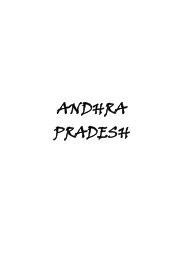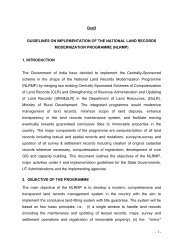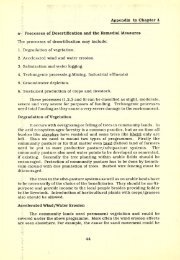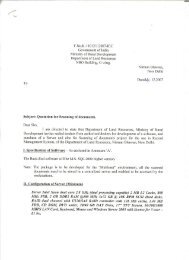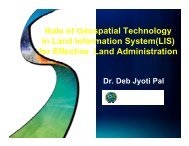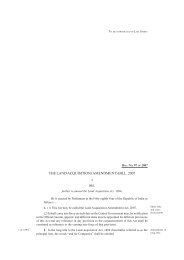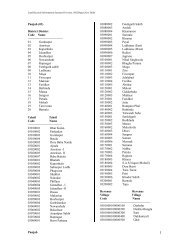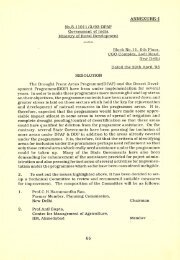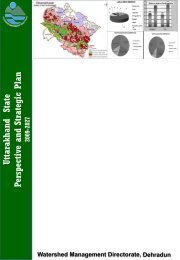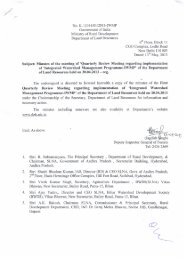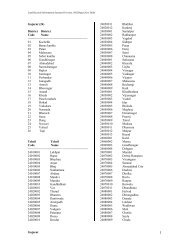Success Stories -NL -Final - Department of Land Resources
Success Stories -NL -Final - Department of Land Resources
Success Stories -NL -Final - Department of Land Resources
You also want an ePaper? Increase the reach of your titles
YUMPU automatically turns print PDFs into web optimized ePapers that Google loves.
NAGAL AND
H.1. Reaping Rich Dividends through Watershed<br />
Programme<br />
A Case Study from Kohima, Nagaland<br />
Problem Statement<br />
Tseminyu sub-division <strong>of</strong> Kohima district with a total geographical area <strong>of</strong> about 284.36 sq.<br />
km occupies the northern part <strong>of</strong> Kohima. Under IWDP<br />
Kohima-V (Tseminyu sub-division) watershed, 16<br />
villages were covered with a treatment area <strong>of</strong> 8200<br />
ha. The villages are Sendenyu, Henbeju, Terogunyu,<br />
Phenwhenyu, Kashanyu, Zisunyu, Tseminyu Village,<br />
Phenshunyu, Khenyu, Ziphenyu, Tesophenyu New,<br />
Nsunyu, Chunlikha, Gukhanyu, K.Nyishunyu, and<br />
Tsonsa. The project was sanctioned during 2003 and<br />
completed in March 2008 and it has benefited a total <strong>of</strong><br />
3,303 households. Agriculture is the mainstay <strong>of</strong> the<br />
people here and vast area practices jhum cultivation.<br />
The socio-economic status <strong>of</strong> the people is very low<br />
due to lack <strong>of</strong> resources and economic opportunity<br />
which leads to migration to urban areas. Large scale<br />
jhumming is practiced leading to excess soil erosion<br />
and degradation <strong>of</strong> natural flora and fauna. To add to<br />
the woes there is acute shortage <strong>of</strong> water for drinking<br />
and farming activities.<br />
Objectives and Methodology<br />
Taking into consideration the above situation efforts were initiated through the project to<br />
uplift the socio-economic status <strong>of</strong> the villagers which would result in reduction <strong>of</strong> migration,<br />
to recharge the ground water in the project area and change the pattern <strong>of</strong> cultivation from<br />
shifting to permanent cultivation. Overall it was expected that these initiatives would restore<br />
the ecological balance and bring about environmental improvement.<br />
The project was implemented mainly<br />
to reclaim the vast jhum land which<br />
lay barren, for afforestation,<br />
horticulture, and cash crop cultivation<br />
and incorporate it with various soil and<br />
moisture conservation measures,<br />
thereby providing subsistence to the<br />
farmers. The IWDP, which<br />
emphasizes on bottom up planning<br />
approach, was well accepted by the<br />
local people. All the activities were<br />
tailored to suit local conditions and<br />
that easily fitted into the jhum system.<br />
The major activities undertaken were:<br />
Photo 1. Map indicating the project<br />
area (Tseminyu sub-division) in Kohima<br />
District<br />
Photo 1. A view <strong>of</strong> the project area devastated by Jhum<br />
before the Project<br />
afforestation, horticulture, cash crop cultivation, soil and moisture conservation measures<br />
like bench terraces, contour bunds and water harvesting structures, formation <strong>of</strong> SHGs.<br />
106
Photo 3. Community Utility Building<br />
constructed at Tseminyu Village<br />
Photo 4 & 5. Water tanks constructed under EPA in kashanyu<br />
and Zisunyu villages<br />
Results and Impact<br />
Under afforestation 15,41,200 hollock and pine saplings were provided covering an area <strong>of</strong><br />
4341 hectares and benefiting 6794 beneficiaries. Out <strong>of</strong> the total saplings planted 6,47,304<br />
trees have survived whose present value stands at Rs.647 lakhs. It is estimated that after 20<br />
years the value <strong>of</strong> these trees would be Rs. 9710 lakhs. In horticulture 315,000 orange,<br />
banana and passion fruit saplings were provided covering an area <strong>of</strong> 370 hectares and<br />
benefiting 697 beneficiaries. Out <strong>of</strong> the total saplings planted 130,300 trees have survived<br />
generating an annual income <strong>of</strong> Rs.449.42 lakhs. Similarly cash crops namely lemon grass<br />
and cardamom covering an area <strong>of</strong> 264 hectares has benefited 528 farmers and fetching an<br />
annual income <strong>of</strong> Rs. 11 lakhs.<br />
Photo 6. Hollock plantation after six years at<br />
Ziphenyu village<br />
Photo 7. Pine Plantation at Tsonsa Village<br />
Photo 8 & 9. Afforestation on contour bunds in Ziphenyu village (pictures taken on 2004 and 2008)<br />
107
Photo 10 & 11. Views <strong>of</strong> the orange plantation at Chunlikha Village (pictures <strong>of</strong> same plot at the initiation <strong>of</strong><br />
the project and after 5 years)<br />
Under soil conservation measures 32 nos <strong>of</strong> water harvesting structures, bench terraces <strong>of</strong><br />
13 units and contour bunds covering 25 ha has been completed. The project has facilitated<br />
in the formation <strong>of</strong> 68 number <strong>of</strong> SHGs with a total membership <strong>of</strong> 977 members (963 female<br />
and 34 male). Each <strong>of</strong> these SHGs have been provided with a seed money <strong>of</strong> Rs 10,000 and<br />
they have taken up income generation activities like weaving, handicraft, kitchen gardening,<br />
piggery, cash crops, micro-enterprise which together has fetched an income <strong>of</strong> Rs. 1.7<br />
crores till date.<br />
Photo 12. Villagers engaged in construction <strong>of</strong> water harvesting structures in Phenwhenyu<br />
Photo 13 & 14. Views <strong>of</strong> bench terraces and water harvesting structures constructed in Phenwhenyu village &<br />
the same put in to Paddy cum Fish Culture<br />
In addition to the above activities, low cost latrines were also constructed for the economic<br />
and socially deprived villages under the project using locally available material and CGI<br />
sheets provided to them. Today, as a result, the village has a cleaner and hygienic<br />
surrounding, and scavenging animals are rarely seen loitering in the village square.<br />
108
Economic Earthen Kitchen (EEK) has been disseminated to all the project villages and by<br />
January 2005 almost 75% <strong>of</strong> the household in the project villages has adopted it. This EEK<br />
is a simple, cost free, mud structure devised to reduce the consumption <strong>of</strong> fuel, thereby<br />
conserving the forest. Reduction in consumption <strong>of</strong> firewood has saved thousands <strong>of</strong> trees<br />
and several rupees each year. It is observed that before the use <strong>of</strong> EEK, the consumption <strong>of</strong><br />
firewood in each house at an average was 5 thaks. After the use <strong>of</strong> EEK the firewood<br />
consumption has been reduced to 3 thaks. It is estimated that about 3.6 lakh worth <strong>of</strong><br />
firewood is saved every year in a village. This amounts to Rs. 57.60 lakh saved in all the 16<br />
villages in a year and Rs` 3.45 crores worth <strong>of</strong> firewood has been saved during six years in<br />
the project villages.<br />
Photo 2. A women beneficiary aside the Economic<br />
Earthen Kitchen provided under the project in<br />
Phenwhenyu village<br />
Photo 3. A view <strong>of</strong> the Low cost latrine<br />
constructed under EPA in Kashanyu village<br />
As a result <strong>of</strong> implementation <strong>of</strong> the project some notable<br />
changes have been noticed viz. the overall environment<br />
has visibly improved, the water table <strong>of</strong> the area has<br />
increased and the duration <strong>of</strong> availability <strong>of</strong> water has<br />
increased from 7-8 months to 9-10 months annually, the<br />
economic condition <strong>of</strong> the villagers has seen an upward<br />
trend, the women folk have been empowered and their<br />
self-esteem boosted as they have become financially<br />
independent by being a member <strong>of</strong> Self Help Group.<br />
Photo 4. Tata mobile purchased by the<br />
Lachai SHG <strong>of</strong> Nsunyu village<br />
109
H.2. Paving the Way to <strong>Success</strong><br />
A Case Study from Mhainamtsi, Nagaland<br />
Peren district occupies the south western tip <strong>of</strong> Nagaland. The entire population is tribal and<br />
economically very poor. People <strong>of</strong> the district depend for their livelihood on subsistence<br />
jhum/shifting cultivation. Mhainamtsi also called the pineapple village under IWDP Peren-I<br />
was sanctioned during 2005-06. The area earmarked for the watershed development was<br />
500 hectares. It is located at a distance <strong>of</strong> 30 km from the district headquarter, Peren. It is<br />
predominantly inhabited by Zeliang and Rongmei tribes. The village has a total <strong>of</strong> 236<br />
households. The literacy rate is relatively very low (33%). The main occupation <strong>of</strong> the<br />
inhabitants is agriculture.<br />
Problem statement:<br />
The major constraint facing the village is the landuse pattern. Shifting cultivation being a part<br />
and parcel <strong>of</strong> the socio-economic life <strong>of</strong> the villagers, inspite <strong>of</strong> its adverse effects on the<br />
ecosystem and productivity, is still practiced. “Community <strong>Land</strong>s” which is <strong>of</strong>ten considered<br />
as free resources by the population, leads to overexploitation and degradation. The area<br />
receives high rainfall but erratic in distribution and high intensity <strong>of</strong> rainfall which compacts<br />
and reduces the chances <strong>of</strong> infiltration. Due to continuous shifting cultivation and premature<br />
cycle, the NPK ratio has declined which has ultimately resulted in alteration <strong>of</strong> soil microorganism.<br />
The system <strong>of</strong> “free grazing” during the winter months was the principal factor for<br />
the failure <strong>of</strong> any plantation in the past. Further the traditional practice <strong>of</strong> burning jungles in<br />
the dry seasons which is predominantly practiced within the district was one <strong>of</strong> the limiting<br />
factors.<br />
Objectives and Methodology<br />
Considering the above situation the programme was implemented with the objective to<br />
increase productivity <strong>of</strong> the land, to increase the water table in the area, to utilize the jhum<br />
lands on a sustainable manner through better agro-forestry practices and there-by promote<br />
overall economic development, reduce migration and restore the ecological balance and<br />
overall environmental improvement.<br />
Within the project area, several activities were undertaken as per the land capability,<br />
suitability and the actual needs <strong>of</strong> the project area. These activities are afforestation,<br />
plantation <strong>of</strong> horticultural crops and cash crops, drainage line treatment by vegetative and<br />
engineering structures, development <strong>of</strong> small water harvesting structures, land development,<br />
in-situ soil and moisture conservation measures-bunding and vegetative barriers.<br />
Photo 1. A view <strong>of</strong> the contour bund made under the<br />
project<br />
Photo 2. A view <strong>of</strong> the water harvesting<br />
structure developed in the project area<br />
110
There were plantation <strong>of</strong> 1.15 lakh nos. <strong>of</strong> teak, gamari, agar and other trees whose present<br />
value is Rs. 1.15 crores and whose value after ten years would be Rs.11.85 crores and after<br />
25 years would be Rs.23.80 crores. In pineapple plantation 78 household were engaged.<br />
These families were earlier involved in jhum practice which fetched an average annual<br />
household earning <strong>of</strong> 6000/-per annum.<br />
Photo 3 & 4. Views <strong>of</strong> the teak plantation (cleaning at the initiation <strong>of</strong> the project and after 4 years)<br />
The area covered under pineapple cultivation was 115 ha and 9.40 lakh pineapple suckers<br />
were planted. The annual production <strong>of</strong> pineapple was 850 MT which brought about an<br />
annual net return <strong>of</strong> Rs. 29.75 lakhs. This provided an average household income <strong>of</strong><br />
Rs.38,000 per annum from pineapple alone. Hence all 78 households have abandoned jhum<br />
practice and are extending their cultivation every year in view <strong>of</strong> the high pr<strong>of</strong>it from<br />
pineapple. Under rubber plantation 21 nos <strong>of</strong> household are engaged. The area covered<br />
under the plantation is 13 Ha, number <strong>of</strong> trees planted are 6000. The plantation which was<br />
done in 2008-09 is expected to fetch Rs.17.00 lakhs return per annum on maturity after 7<br />
years.<br />
Photo 5. A view <strong>of</strong> the pineapple plantation raised<br />
under the project<br />
Photo 6. A view <strong>of</strong> the field with freshly<br />
planted rubber seedlings amid pineapple plants<br />
Apart from plantation activities the project has promoted 7 nos. <strong>of</strong> SHGs with a total<br />
membership <strong>of</strong> 74. Each SHG has been provided with Rs. 10,000 and they have taken up<br />
weaving, micro-credit, kitchen gardening, piggery, cash crop cultivation which has generated<br />
an income <strong>of</strong> Rs. 9.70 lakhs till date.<br />
Photo 7. Zangna SHG members in action<br />
Photo 8. National level Monitor interacting<br />
with members <strong>of</strong> Luireu SHG<br />
111
Results and impact<br />
IWDP intervention was targeted at the jhum system for productive utilization <strong>of</strong> the land.<br />
IWDP was well accepted by the local people as well as activities and tailored to suit the local<br />
conditions that easily fitted into the jhum system. The total number <strong>of</strong> household benefited by<br />
the project intervention was so far 172 nos. It is evident that IWDP has increased<br />
productivity <strong>of</strong> the land and has greatly improved the economic conditions <strong>of</strong> the people. It<br />
has also resulted in greater women’s participation, greater access to income generating<br />
opportunities, sharing <strong>of</strong> benefits by the community, assets for the weaker sections <strong>of</strong> the<br />
people, employment opportunity for the landless and the weaker sections. Besides,<br />
improved productivity in the watershed, improved availability <strong>of</strong> timber, fuel-wood and fodder,<br />
increase in the water table in the area, reduction in migration from rural areas, improvement<br />
<strong>of</strong> economic status <strong>of</strong> the people and above all restoration <strong>of</strong> ecological balance and over-all<br />
environmental improvement has made a lasting impact in the area.<br />
112
H.3.Heralding the <strong>Success</strong> <strong>of</strong> Watershed Programme<br />
A Case Study from Tuimei, Nagaland<br />
Tuimei is separated from the district headquarter by a distance <strong>of</strong> 21 km. The general<br />
topography <strong>of</strong> the village is mainly hilly terrain except for some narrow basins. The altitude is<br />
340 m above mean sea level. The village has a population <strong>of</strong> 883 while literacy rate is 37<br />
percent. Agriculture occupies the main source <strong>of</strong> income for the villagers. The major crops<br />
grown are rice, maize, millets, betel vine and vegetables. The climate is <strong>of</strong> sub-tropical and<br />
the soil is sandy-clay with medium organic content.<br />
The IWDP Mon-III was started in the year 2005.Tuimei is one <strong>of</strong> the villages covered under<br />
IWDP Mon – III. The name <strong>of</strong> the micro-watershed is named as the Shamjung project. The<br />
project covers an area <strong>of</strong> 450 ha.<br />
Problem statement<br />
Some <strong>of</strong> the major constraints facing the villagers before the implementation <strong>of</strong> the project<br />
are : Low economic status <strong>of</strong> the people, majority <strong>of</strong> the farmers depend on Jhum cultivation/<br />
shifting cultivation which leads to low productivity, soil erosion, ecological imbalance and<br />
reduction in soil fertility, no suitable measures to control several types <strong>of</strong> erosion, excessive<br />
surface run<strong>of</strong>f has led to decrease in groundwater level, no measures were taken up to<br />
conserve the surface run<strong>of</strong>f.<br />
Objectives and methodology<br />
The objectives were set after considering the social and economic needs <strong>of</strong> the people and<br />
its pros and cons on the local environment.<br />
i) To actively involve the rural people at every stage <strong>of</strong> executing the project right from<br />
the planning stage to suit the needs <strong>of</strong> the people through trainings, capacity building<br />
and social mobilization.<br />
ii) Harnessing and utilizing the age old indigenous technology <strong>of</strong> the farmers and locally<br />
available materials and unexplored resources so as to facilitate convenience and<br />
acceptability <strong>of</strong> the technology transmitted to the rural people.<br />
iii) Jhum cultivation as elsewhere in Nagaland is the dominating land-use system with<br />
long and deep historical roots, so to make-up for the losses caused during the slash<br />
and burn process <strong>of</strong> Jhum cultivation, development <strong>of</strong> various plantation tree species,<br />
horticultural crops, cash crops etc which can be <strong>of</strong> commercial importance so as to<br />
generate income and employment for the people.<br />
iv) To take up measures for soil conservation in areas where there are high threats <strong>of</strong><br />
erosion such as rain, wind, run<strong>of</strong>f etc.<br />
v) To tape the run<strong>of</strong>f water through construction <strong>of</strong> water harvesting structures, check<br />
dams, percolation tanks etc. for raising the water table in the watershed.<br />
vi) To give equal importance to women folks through formation <strong>of</strong> SHGs so as to enable<br />
them to be financially secure, expose their inner potential as well as to make<br />
contribution to meet the needs <strong>of</strong> their family.<br />
Various activities were taken up after taking into account its sustainability on that particular<br />
area, the needs and their suitability on the rural people. This was done through a month long<br />
extensive survey. At every phase, the opinions <strong>of</strong> the people were taken into account and by<br />
utilizing the available natural resources that will suit the soil and climatic condition <strong>of</strong> that<br />
particular area. The activities taken up were-:EPA (Entry point activity) afforestation,<br />
plantation <strong>of</strong> horticultural and cash crops, soil conservation measures, formation <strong>of</strong> SHG,<br />
installation <strong>of</strong> lemongrass farm along with distillation unit, setting up <strong>of</strong> model farm .<br />
113
IWDP was able to meet the set objectives, thus bringing a breath <strong>of</strong> fresh air into the lives <strong>of</strong><br />
the people. It was suitable for the local environment as all the activities were taken up<br />
keeping in mind the adaptability, convenience and its accessibility to the local people. The<br />
activities were quiet productive and generated the desired outcome. For example<br />
construction <strong>of</strong> community toilet for the convenience <strong>of</strong> the villagers as well as for the<br />
passers-by for maintenance <strong>of</strong> sanitation in the village and purchase <strong>of</strong> plastic chairs for use<br />
in community gatherings and meetings.<br />
Under afforestation 45000 hollock, khokkon and gamari saplings were provided covering an<br />
area <strong>of</strong> 45 hectares. Out <strong>of</strong> the total saplings planted 30,000 trees have survived whose<br />
present value stands at Rs.30 lakhs. It is estimated that after 20 years the value <strong>of</strong> these<br />
trees would be Rs. 150 lakhs. In horticulture 314,000 orange, areca nut, tea and lemon<br />
grass saplings were planted covering an area <strong>of</strong> 54 hectares. Out <strong>of</strong> the total saplings<br />
planted 301,000 trees have survived generating an annual income <strong>of</strong> Rs.58.56 lakhs.<br />
Under soil conservation measures 3 units <strong>of</strong> water harvesting structures, 3 water tanks and<br />
1500 meters <strong>of</strong> irrigation channel has been completed. The project has facilitated in the<br />
formation <strong>of</strong> four SHGs and they have taken up income generation activities like poultry,<br />
goatery, weaving, kitchen gardening, tea plantation, coconut plantation etc.<br />
Photo 1. A view <strong>of</strong> the water harvesting structure developed under the project<br />
Lemongrass or the commonly known citronella is a high valued crop, with multiple uses,<br />
easy to maintain, ideal soil binder in hilly areas which are more prone to soil erosion and<br />
suitable in different climatic conditions. Lemongrass farm along with distillation unit was<br />
established on 4 th July, 2008. The area under cultivation is 12ha and harvesting is done 5<br />
(five) times in a year. The oil sold so far is 2100 kg.<br />
Photo 2 & 3. Views <strong>of</strong> lemongrass field and the distillation unit<br />
114
EVALUATION / EVIDENCE AND REPLICABILITY :<br />
The project has the power to create a socio-economic revolution among the rural masses. It<br />
has not only produced tangible assets and improved the living conditions <strong>of</strong> the people, but<br />
also helped them in changing much <strong>of</strong> their social and economic outlook and attitudes. The<br />
success <strong>of</strong> the programme is evident from reduced poverty, rural employment, and<br />
enhanced economic opportunities, better education <strong>of</strong> the children, improved living<br />
standards, conservation <strong>of</strong> natural resources and a cleaner environment. The secret for the<br />
success lies in motivation <strong>of</strong> the target group and the integrated approach to involve them<br />
right from the planning till the implementation stage, thus facilitating two-way traffic between<br />
the rural masses and the implementing agency. The potential for its replication in other<br />
places depends on the adoption <strong>of</strong> right approach and the techniques involved in its<br />
execution. The people <strong>of</strong> the Tuimei village themselves are the testimony <strong>of</strong> the success <strong>of</strong><br />
the programme to other people in different areas.<br />
115
H.4. A <strong>Success</strong>ful Venture through Watershed<br />
Programme<br />
A Case Study from Wokha, Nagaland<br />
IWDP Project-II in Wokha district <strong>of</strong> Nagaland covers 17 micro-watersheds which were<br />
scattered in all the five RD Blocks. A total <strong>of</strong> 17 villages with target area <strong>of</strong> 8300 Ha was<br />
covered. The conditions <strong>of</strong> the areas were pathetic, and with the lack <strong>of</strong> knowledge for<br />
resource utilization as well as minimum economic opportunities, it was evidently under<br />
poverty. There was large scale dependency on jhumming where 82% <strong>of</strong> the watershed<br />
community was engaged.<br />
PROBLEM STATEMENT<br />
With Jhum cultivation as the main livelihood activity, sustainable economic activity has slow<br />
progress. Due to excessive jhumming activity, there is rapid degradation <strong>of</strong> forest land, soil<br />
erosion and decreased water table. With the decreasing jhum cycle to 4-5 years which<br />
earlier was a cycle <strong>of</strong> 6-8 years, and increasing rural population leading to larger utilization <strong>of</strong><br />
jhum land, the once fertile land has been exhausted leading to result <strong>of</strong> low productivity <strong>of</strong><br />
jhum paddy and other agriculture products. This practice has also caused tremendous loss<br />
<strong>of</strong> both flora and fauna and habitat <strong>of</strong> many wild animals.<br />
Apart from this condition, it is faced with many problems, such as: lack <strong>of</strong> drinking water,<br />
lack <strong>of</strong> scientific method <strong>of</strong> farming, lack <strong>of</strong> accessibility to markets, there is a problem for<br />
various departments to undertake developmental activities due to lack <strong>of</strong> transport and<br />
communication.<br />
OBJECTIVES & METHODOLOGY<br />
With the above situation in mind, the project was implemented with the objectives <strong>of</strong><br />
optimum utilization <strong>of</strong> natural resources, employment generation through Income Generating<br />
Activities, to achieve sustainable productivity with the available resources, to improve overall<br />
condition <strong>of</strong> the watershed through plantation <strong>of</strong> various economic/commercial plants and<br />
crops viz. teak, gamari, hollock, orange, pineapple, rubber, areca nut, banana etc. to check<br />
degradation <strong>of</strong> land through construction <strong>of</strong> soil and moisture conservation structures such<br />
as Bench terraces, Water Harvesting Structures, Check Dams, etc. and,to promote scientific<br />
management and improvise the traditional methods <strong>of</strong> farming with active participation <strong>of</strong> the<br />
watershed community.<br />
IWDP intervention was targeted at the jhumming system for productive utilization <strong>of</strong> land. It<br />
was well accepted by the people as the activities were shaped to suit the local conditions<br />
that fitted easily into the jhum system.<br />
Activities taken up under IWDP Wokha-II project can be broadly classified into two general<br />
categories, namely production and treatment activities.<br />
Production activity consisted <strong>of</strong> afforestation, horticulture development and cash crops. Tree<br />
species <strong>of</strong> high commercial values such as, teak, gamari, hollock etc. were planted under<br />
afforestation. Major crops under horticulture & plantation crops consisted <strong>of</strong> oranges,<br />
pineapple, banana, arecanut, rubber plantation etc. Cash crops and medicinal & aromatic<br />
plants consisted <strong>of</strong> sugarcane, lemongrass, patchouli, agar etc. have been introduced to the<br />
project communities to fetch good economic return in short term.<br />
Treatment activity consisted <strong>of</strong> building bench terraces, contour bunds, check dams and<br />
water harvesting structures. Conservation structures have been built in the micro-watershed<br />
116
where degradation <strong>of</strong> forest due to jhumming, splash from rain drops and gully from run<strong>of</strong>f<br />
are expected to cause serious soil erosion. A tabular view <strong>of</strong> the achievements <strong>of</strong> the project<br />
is presented in table 1 and table 2<br />
Table 1: Physical achievements <strong>of</strong> different activities under the project:<br />
Sl. Activity Achievement<br />
1 E.P.A 17 Nos.<br />
2 SHG 134 Nos.<br />
3 Training 70 Nos.<br />
4 Afforestation 2756 Ha.<br />
5 WHS 34 Nos.<br />
6 Bench Terrace 102 Ha.<br />
7<br />
Horticulture, Plantation Crops<br />
& Cash Crops<br />
2312 Ha.<br />
Photo 1 . A view <strong>of</strong> the members <strong>of</strong> Telongla SHG <strong>of</strong> Lakhuti Village<br />
Table 2: Changes in <strong>Land</strong> Cover Pattern before and after intervention <strong>of</strong> the project:<br />
<strong>Land</strong> use –<br />
<strong>Land</strong> cover pattern<br />
Pre-project Status<br />
(Ha.)<br />
Post-project status<br />
(Ha.)<br />
i) Forest <strong>Land</strong><br />
ii) Current Jhum <strong>Land</strong><br />
iii) Abandoned Jhum <strong>Land</strong><br />
iv) Terrace <strong>Land</strong><br />
v) Pasture /Grazing <strong>Land</strong><br />
vi) Cultivable <strong>Land</strong><br />
vii) Barren/ Un-cultivable <strong>Land</strong><br />
viii) Orchard/Garden <strong>Land</strong><br />
0.00<br />
3791.50<br />
3892.50<br />
12.00<br />
0.00<br />
281.00<br />
324.00<br />
0.00<br />
2756.00<br />
1424.00<br />
522.00<br />
102.00<br />
0.00<br />
860.00<br />
324.00<br />
2312.00<br />
TOTAL 8300.00 8300.00<br />
Photo 2& 3 . Views <strong>of</strong> Hollock and teak plantations in Pankti and Wokha village, respectively<br />
117
The project started with need base entry point activities such as, construction <strong>of</strong> resting<br />
shed, marketing sheds, water reservoir etc. were taken up through community participation.<br />
It is estimated that a total asset worth <strong>of</strong> Rs. 50.00 lakhs have been created in the watershed<br />
villages which are well maintained by the community. There after number <strong>of</strong> trainings were<br />
conducted to the project community for participation in watershed development, where<br />
various PRA tools were used in imparting trainings to the Watershed Committee members,<br />
project Users Group & Self Help Groups. Various forms <strong>of</strong> awareness, meetings,<br />
demonstration, field visit, exposure trips, audio-visual aid were used to create interest and<br />
enthuse the project stakeholders. Innovative ideas have also been introduced to the people<br />
such as use <strong>of</strong> earthen curry pot, economic kitchen, bee keeping, broom stick cultivation etc.<br />
Photo 4. A view <strong>of</strong> the Resting Shed constructed as<br />
part <strong>of</strong> EPA at Pangti Village<br />
Photo 5. A view <strong>of</strong> the participants in a<br />
Block level training in Wokha<br />
A documentary booklet and audio-visual aids <strong>of</strong> successful farmers, achievers and upcoming<br />
interested farmers were used as a tool for trainings. Large photographs and banners were<br />
displayed during important functions and occasions. Documentations made by various<br />
Government agencies and NGOs were aired by media and published in the local dailies.<br />
<strong>Success</strong>ful farmers and achievers were engaged as master trainers and resource persons.<br />
Field trips as exposure tours were organized for the farmers in the fields <strong>of</strong> successful farms.<br />
The project has facilitated in the formation <strong>of</strong> a number <strong>of</strong> Self Help Groups. Out <strong>of</strong> the total<br />
target i.e. 100 SHGs within the project duration as per the Annual Action Plan (AAP), a total<br />
<strong>of</strong> 134 SHGs has been already formed till date and registered under LRD, and out <strong>of</strong> which<br />
72 are active. Kitchen garden, backyard poultry and micro-financing activities are carried out<br />
by the groups. Each group has an average income <strong>of</strong> Rs. 40,000/- annually. A total <strong>of</strong> Rs<br />
1.34 crores has already been generated so far.<br />
Under afforestation, tree species such as Alder, Teak, Gamari, Hollock, Pine & Local<br />
Species were introduced. A total <strong>of</strong> 2756 Ha. has been actually covered with present<br />
standing trees <strong>of</strong> 8,26,800.00 Nos. on average <strong>of</strong> 6-7 years. The present value is estimated<br />
at Rs. 20 Crores from estimated volume <strong>of</strong> 17,53,600 cft. The estimated volume after 20<br />
years is Rs. 40 crores. Orange and Arecanut were the main horticulture crops taken up. It<br />
covers an area <strong>of</strong> 1912 Ha. with 10,70,720 Nos. <strong>of</strong> standing plants. It is estimated to have an<br />
earning <strong>of</strong> Rs. 0.78 crores annually. Tea and Rubber plantations were the main plantation<br />
crops undertaken under IWDP-II. Tea Plantation covers an area <strong>of</strong> 85.00 Ha. which is<br />
estimated to have an earning <strong>of</strong> Rs. 0.37 lakh which has just 24 rounds <strong>of</strong> plucking annually.<br />
Rubber plantations cover an area <strong>of</strong> 65 Ha. with a total <strong>of</strong> 29,250 standing trees. It is<br />
estimated to have an earning <strong>of</strong> Rs. 0.13 crores annually from its harvest. Sugarcane,<br />
pineapple and passion fruits are major cash crops taken up. It covers an area <strong>of</strong> 250 Ha. It is<br />
estimated to have an average earning <strong>of</strong> Rs. 0.31 crores annually.<br />
118
Photo 6 & 7. Views <strong>of</strong> orange and passion fruit plantations in Pyansa and Wokha villages, respectively<br />
Photo 8 & 9. Views <strong>of</strong> Rubber and tea plantations in Lakhuti and Lio-Longidang villages, respectively<br />
Photo 10 . A view <strong>of</strong> arecanut plantation in Champang village<br />
Under Water harvesting structures, a total <strong>of</strong> 34 Units has been constructed. It has been<br />
estimated that Rs.1.75 lakhs has been an average earning annually. A total <strong>of</strong> 102.00 Ha. <strong>of</strong><br />
bench terrace has been developed in different location <strong>of</strong> the watersheds. It is estimated an<br />
average yield <strong>of</strong> 2,380 Quintals annually, earning them a total <strong>of</strong> Rs. 10.00 Lakhs.<br />
119
Photo 11 . View <strong>of</strong> a water harvesting structure<br />
at Longsa Village<br />
Photo 12 . A view <strong>of</strong> Bench Terrace at<br />
Bhandari Village<br />
Implementation <strong>of</strong> IWDP project has been a blessing to the watershed communities. Looking<br />
at the condition and assessing the problems being faced in the areas, one can assume that<br />
the continuing trend <strong>of</strong> jhum farming along with the growing rural population would soon<br />
have disastrous consequences.<br />
With the implementation <strong>of</strong> IWDP Project, various achievements and benefits have accrued<br />
in the village namely : improvement in economic status, mobilization through trainings,<br />
demonstrations and exposure tours, increase in farming and productivity, decrease in<br />
migration ,increase in use <strong>of</strong> scientific technology, increase in water table, increase in<br />
afforestation.<br />
Implementation <strong>of</strong> IWDP-II in Wokha district has many remarkable achievements. In short, it<br />
is a total success. The success <strong>of</strong> rubber plantation at Chudi village, tea plantation at Lio-<br />
Longidang village and orchards at Pangti village has set an example in the minds <strong>of</strong> farmers<br />
from other villages.<br />
120
H.5. Longleng District Paves The Way <strong>Success</strong>ful<br />
Watershed Programme Implementation<br />
A Case Study from Longleng, Nagaland<br />
Longleng got the status <strong>of</strong> district in the year 2003 after curving out from erstwhile<br />
Tuensang. It shares the boundary with Mokokchung to the east, Assam to the west and<br />
Tuensang to the north. Justice could not be delivered in developmental works to the people<br />
inhabited in the district before Longleng got the status <strong>of</strong> the district due to vast geographical<br />
area. The <strong>Department</strong> <strong>of</strong> <strong>Land</strong> <strong>Resources</strong> for the first time worked with the people <strong>of</strong> the<br />
district independently in the year 2005 in IWDP Project-I. The Project which was sanctioned<br />
in 2005-06 for a period <strong>of</strong> five years has covered 17 villages with a total target area <strong>of</strong> 8300<br />
Ha.<br />
The status <strong>of</strong> the Micro watershed village was in pitiable condition where almost 90%, <strong>of</strong> the<br />
people inhabited. The micro watershed depends on Jhuming for their livelihood which<br />
reflects the socio economic condition <strong>of</strong> the people inhabited in the area. With almost 90% <strong>of</strong><br />
the micro water shed villagers depending on Jhuming for livelihood sustainable economic<br />
activities could not be derived, due to which the upcoming youngster are not attracted to the<br />
village and migrate to the urban areas. After assessing the need <strong>of</strong> the people in the district,<br />
the <strong>Department</strong> has selected 16 micro-villages spread over two blocks in the entire district<br />
for the first phase <strong>of</strong> IWDP-1.<br />
Embracing Jhum, which is the only source <strong>of</strong> livelihood for the micro water shed villagers<br />
have depleted natural resources rampantly. At the same time with the increase <strong>of</strong> population<br />
Jhum cycle which was 13-15 years before was reduced to 8-9 years. This in turn has<br />
affected the eco system and the environment they inhabit. Not only this the Microwatershed<br />
villagers are faced with numerous problem such as lack <strong>of</strong> proper transport &<br />
communication, inadequate health facility, lack <strong>of</strong> scientific method <strong>of</strong> farming, poor socio<br />
economic condition etc and are also excluded from the rest <strong>of</strong> the people due to poor road<br />
communication and remoteness.<br />
Photo 1 . A side view <strong>of</strong> Washershed Project Site <strong>of</strong> Yaongyimchem Village<br />
Excessive Jhum not only resulted in depletion <strong>of</strong> natural resources but also caused rapid<br />
degradation <strong>of</strong> forestland, increased soil erosion and reduced water table in many micro<br />
water shed areas. The once fertile Agri land has lost its fertility leading to low productivity <strong>of</strong><br />
Agri product; it not only has adverse effect on environment but has also affected the rich<br />
flora and fauna <strong>of</strong> the land leading inexorably to the erosion <strong>of</strong> biodiversity.<br />
121
With a vision to manage and utilize run<strong>of</strong>f water for sustainable land management ,increase<br />
agricultural production , to develop suitable site-specific soil and water conservation<br />
measures and also to improve land and water resources for income generating enterprises<br />
and to maintain the ecological balance IWDP project has been introduced.<br />
Activities taken up under IWDP Longleng project-1 can be broadly classified into two general<br />
categories, namely production and treatment activities. Production activity consisted <strong>of</strong><br />
afforestation, horticulture development and cash crops. Tree species <strong>of</strong> high commercial<br />
values such as, teak, gamari, hollock etc. were planted under afforestation. Major crops<br />
under horticulture & plantation crops consisted <strong>of</strong> oranges, banana, betel vine, sugarcane,<br />
etc. have been introduced to the project communities to fetch good economic return within<br />
short term.<br />
Soil & water works activity consisted <strong>of</strong> building bench terraces, contour bunds, check dams<br />
and water harvesting structures were taken up to improve the water table . At the same time<br />
it would help to go for seasonal crop growth for economic benefit and also to retain the jhum<br />
land from erosion.<br />
Conservation structures have been built in the micro-watershed to prevent the degradation<br />
<strong>of</strong> forest due to jhumming, splash from rain drops and gully from run<strong>of</strong>f which may cause<br />
serious soil erosion.<br />
Numbers <strong>of</strong> trainings were imparted to the project community for participation in watershed<br />
development. Various PRA tools were used in imparting trainings to the Watershed<br />
Committee members, project Users Group & Self Help Groups. Besides awareness,<br />
meetings, demonstration, field visit, exposure trips, audio-visual aid were used to create<br />
interest and enthuse the project stakeholders. Innovative ideas have also been introduced to<br />
the people such as economic kitchen, bee keeping, broom stick cultivation etc.<br />
Photo 2 . Farmers take <strong>of</strong>f an exposure visit<br />
Photo 3 . On hands training during field<br />
visit<br />
A total <strong>of</strong> 105 SHGs has been already formed till date and registered under LRD, and out <strong>of</strong><br />
which 85 are still active. Activities such as kitchen garden, backyard poultry, weaving and<br />
micro-financing are their main components. Each group has an average income <strong>of</strong> Rs.<br />
35,000/- annually.<br />
Under afforestation, tree species such as Gamari, Hollock & Khokon was introduced.<br />
However, Hollock and Khokon were taken as major species, <strong>of</strong> 280000 nos <strong>of</strong> standing<br />
Khokon tree covering an average <strong>of</strong> 312 Ha. may fetch an amount <strong>of</strong> Rs 280 lakhs when<br />
sold @ Rs 100 per cft at present value. And for 2,40,000 nos <strong>of</strong> standing Hollock tree in 267<br />
Ha an amount <strong>of</strong> 240 lakhs can be fetched when sold @Rs 100 per cft. at present value.<br />
122
Photo 4 . Gamari Plantation at<br />
Yaongyimchem<br />
Photo 5 . Hollock Plantation at<br />
Orangkong<br />
Photo 6 . Khokon Plantation at<br />
Yongshei<br />
The micro water shed is blessed with rich vegetation and good climatic condition suitable for<br />
many horticultural crops. The department consulted the experts and after assessing the<br />
suitability has introduced Orange, Banana, Litchu, Cardamom, Pineapple and Betel Vine as<br />
the main crops taken up during the project period. A total 240.19 Ha area has been covered<br />
under horticulture. There are a total <strong>of</strong> 2,74,385 standing plants which fetches a present<br />
annual income <strong>of</strong> Rs 59.7 lakhs.<br />
Photo 7 . Cardamom plantation under the project<br />
in Yaong<br />
Photo 8 . Pineapple plantation under the<br />
project in Yongam<br />
Photo 9 . Arecanut plantation under the project in Yongam<br />
The income generated by these villagers have spread a message that jhum is not the only<br />
source <strong>of</strong> livelihood and have influenced the nearby villages to start taking up these crops as<br />
an alternate livelihood leaving Jhum, which would in turn save flora and fauna.<br />
123
Photo 10 . Apiculture as a livelihood activity in the project area<br />
Under soil and water conservation 80 unit <strong>of</strong> Water harvesting structures, 48 unit <strong>of</strong> bench<br />
terrace, 96 unit <strong>of</strong> check dam and 117 unit <strong>of</strong> counter bund have been developed during the<br />
project period. The activities under Soil & Water Conservation have generated a greater<br />
turnover in the production <strong>of</strong> seasonal crop giving an input <strong>of</strong> about 15 lakhs per annum. Dry<br />
stream and ponds are also seen to have regained water in it, which shows the rate <strong>of</strong> water<br />
table has improved due to soil and water work activities.<br />
Photo 11 . Villagers at work in making irrigation<br />
channel at Yaongyimchem village<br />
Photo 12 . Contour Bundings at Alayong<br />
Village<br />
Photo 13 . Construction <strong>of</strong> a water harvesting<br />
structure in Tangha village in progress<br />
Photo 14 . A water harvesting structure<br />
constructed under the projects in Orangkong<br />
124
Photo 15 . Bench Terracing at Yaongyimchem Village<br />
Implementation <strong>of</strong> IWDP project in Longleng district has brought sea <strong>of</strong> changes in many<br />
areas in the lives <strong>of</strong> the micro watershed villagers. The social economic condition has<br />
improved, women folk are seen engaged in income generating activities, farmers are taking<br />
up alternative method <strong>of</strong> livelihood leaving Jhum practice.<br />
Imparting training and seminar to the entire user group in the micro water shed villages<br />
during the project period has also motivated the villagers thereby leading them to judiciously<br />
use natural resources in a sustainable way. They have also learnt to preserve and conserve<br />
flora and fauna in the micro watershed villages. Their input <strong>of</strong> indigenous knowledge mixed<br />
with modern method <strong>of</strong> farming and preservation <strong>of</strong> flora and fauna not only benefited the<br />
villagers but allied land based department.<br />
125




